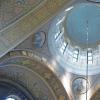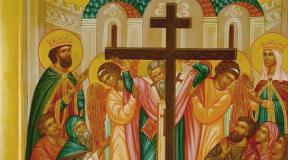Early Latin Patristics. History of Philosophy Latin Patristics
For Latin Patristics, it has the same meaning as Origen for Greek. In the person of Tertullian, the West received its theorist even earlier than the East: “As Origen among the Greeks, so he [Tertullian] among the Latins, of course, must be considered the first among all ours,” wrote the monastic theologian of the early 5th century Vikenty Lerinsky (“ Precept "18).
Tertullian received a good education, including, probably, law. According to some reports, he was a priest, but then joined the sect of religious fanatics - "Montanists". From the writings of Tertullian, one can easily get an idea of \u200b\u200bhis character - passionate, adamant, avoiding compromise.
Among the three dozen surviving treatises of Tertullian are especially important: "The Apologetician", "On the testimony of the soul", "On the soul", "On the prescription against heretics", "On the flesh of Christ", "Against Hermogenes", "Against Praxeus", "Against Marcion ". In contrast to the Alexandrians, Tertullian represented the radical "anti-gnostic" trend of patristism, which preferred to single out a purely religious "pole" in Christianity. Although in spirit Tertullian is close to the apologists and does not possess Origen's systematic pathos, he did a lot for the formation of dogmatism. He can rightfully be considered the "father" of Latin theological vocabulary. In addition, he was the first to speak about the predominant authority of the Roman See.
The theoretical teaching of Tertullian is not brought into the system. Theology, cosmology, psychology and ethics are sometimes presented in a mixture. In addition, this doctrine is marked by the strong influence of Stoicism: in this respect, it can be considered a unique phenomenon of patristism. Declarative "somatism" leads Tertullian to assert the corporeality of all things - including the soul and God Himself. At the same time, “body” and “flesh” are different things: spirit differs from flesh in a qualitatively different corporeality. The doctrine of the Trinitarian unity of God, developed in the treatise Against Praxeus, largely anticipates the later orthodox formulations (Tertullian insists on the substantial unity of the Trinity, which Origen and Arius denied), but still suffers from subordinationism. Tertullian's theory of knowledge is an example of Stoic sensationalism. For Tertullian's psychology, the treatise "On the Soul" is especially important, where, along with his own views, the opinions of numerous ancient authors are set forth. So Tertullian's theory is interesting, unusual, but just as uncanonical as Origen's theory. However, the true meaning of this thinker is not contained in abstract theorizing.
An important feature of Tertullian's worldview is demonstrative antiphilosophy and antilogicality, openness to contradictions, paradox, designed to open the depths of faith. If for Clement of Alexandria the whole world was "Athens", then Tertullian wanted to have before his eyes only "Jerusalem", separated from "Athens" by an insurmountable abyss: "What do Athens and Jerusalem, the Academy and the Church have in common?" ("On the prescription" 7 Pagan philosophy is the mother of heresies, it is incompatible with Christianity. Only the soul itself, “a Christian by nature.” God is above all the laws that philosophizing reason seeks to impose on Him, it is incompatible with Christianity. Natural human questions “why are absolutely inapplicable to Him and His actions. ?" and for what?".
Formation of medieval philosophy.
Latin patristics
Introduction. CONCEPT AND PROBLEM OF MEDIEVAL PHILOSOPHY
The division of history into ancient, medieval and new has long been generally accepted. However, the application of this kind of periodization to the history of philosophy and the history of culture in general causes serious difficulties. First of all, the problem arises of its universal applicability in the spatial and geographical sense. Can we talk, for example, about antiquity or the Middle Ages in relation to Indian, Chinese, Arab, or Russian philosophy and culture? Or, to say so - means to be a prisoner of the long-obsolete Eurocentrism? Another problem: if we restrict the scope of application of this periodization only to the cultural and ideological history of Western Europe, is it possible to determine the chronological framework of each period with any precision? What moments should end the history of ancient philosophy and from what point should the history of medieval philosophy begin? Where does medieval philosophy stop and where does the new one begin? It is impossible to answer these questions without understanding what meaning we mean in the concept of "medieval philosophy". Of course, chronology will not determine this meaning, but, on the contrary, the meaning we have established will determine the chronology.
Consideration of medieval philosophy simply as the philosophy of a certain time period - the Middle Ages would require us to preliminary clarify the very term "Middle Ages", which is a very difficult task and is still not fully resolved. The disadvantage of most modern studies on medieval philosophy is precisely that they either associate its beginning with some date in political history (with the date of the fall of the Western Empire - 476; with the date of the coronation of Charlemagne - 800, etc.). ), or completely omit the problem of its beginning, timing its emergence with some of the philosophers, for example, Augustine, or making it in fact a simple continuation of ancient philosophy.
More justified, in our opinion, is this approach to medieval philosophy, when this term is associated primarily with historically unique way of philosophizing characteristic of Europe and the Middle East of the era of feudalism, however, which arose long before the establishment of classical feudalism and left the historical scene much earlier than European feudalism finally left it. The originality of this method of philosophizing was his association with religious ideology, based on the principles of revelation and monotheism, that is, on the principles that were common to Judaism, Christianity and Islam, but essentially alien to the ancient religious and mythological worldview. This fundamental dependence on religious ideology did not mean for philosophy its complete dissolution always and everywhere in religious consciousness, but all the same throughout the entire period it determined both the specifics of philosophical problems and the choice of ways to resolve them.
Whatever the position of the medieval philosopher, it is always marked by a deep "preoccupation" with religion and theology, whether it be the preoccupation with how to put philosophy at the service of religion inherent in the early Middle Ages, or the preoccupation with how, while maintaining the loyalty of religion, liberate philosophy from under the theological tutelage inherent in the late Middle Ages. The historically conditioned cohabitation of philosophy and theology, sometimes quite peaceful, sometimes turning into open confrontation (for example, in the case of Berengari, Abelard or Seager of Brabant), but always unequal and almost always vassal, gave the philosophical identity of the Middle Ages a unique flavor, by which it is easy to identify and distinguish it from the philosophical self-consciousness of antiquity or modern times. The theological idea fulfilled the same regulatory function for the medieval philosopher, which the aesthetic-cosmological idea fulfilled for the ancient, and the idea of \u200b\u200bscientific knowledge for the philosopher of modern times. From this it is clear what the chronological framework of medieval philosophy should be. Its history must begin from the moment when philosophy first consciously places itself at the service of religion and revelatory theology, and end when the alliance between philosophy and revealed theology can be considered largely disintegrated. But the first serious attempts to use philosophy for the purposes of the religion of revelation belong to Philo of Alexandria and Christian apologists, and the last Udyrs in a philosophical-theological alliance were inflicted in Occam's nominalistic-sensualist school, where the theory of "two truths", ideologically subversive for the Middle Ages, was finally established.
So, in accordance with this approach, the history of medieval philosophy should begin from the 1st-2nd centuries. and end the XIV - XV centuries. Only in this case it is possible to avoid the artificial separation of such directly related phenomena of ideological history as patristics and scholasticism, and also to correctly interpret the anti-dogmatic and anticlerical sharpness of the philosophy of the Renaissance. A similar approach to the history of medieval thought was implemented in the works of E. Gilson, M. de Wolfe, M. Grabman and some others. At the same time, we will not find in these works the necessary socio-historical substantiation of the peculiarities of medieval thinking. The interdependence of philosophy and theology is interpreted here as a kind of historical reality that needs a phenomenological rather than a deterministic analysis; the beginning and the end of this interdependence are seen as events of the inner life of culture in isolation from the socio-economic context. Of course, cultural and ideological history has a certain independence, which allows us to apply a special periodization to it (antiquity, the Middle Ages, the Renaissance, the New Time), in contrast to the socio-economic periodization corresponding to social formations. However, the facts of cultural and ideological history have a striking isomorphism in relation to the events of socio-economic history and become fully understandable only in connection with the latter. It is no coincidence that the emergence of the way of philosophizing characteristic of the Middle Ages in the first centuries of the new era coincides with the beginning of the crisis of the slaveholding mode of production and the emergence of proto-feudal relations in Greco-Roman society. It is no coincidence that medieval forms of philosophizing begin to outlive themselves precisely when, in the most developed regions of Europe, a new, bourgeois system comes to replace feudalism. Undoubtedly, medieval philosophy is at its core the philosophy of feudal society, it is an ideologically transformed reflection of the existence of a "feudal" person. But to the extent that feudal society had its preconditions and its "anticipations" in the socio-economic and ideological realities of the late slave-owning society, in the same measure medieval philosophy began its history in the bosom of late antique culture as an abstract theoretical reflection of these realities, and often as a reflection outstripping, catching in the barely noticeable glimpses of a new era, its midday glow. Paradoxically, medieval philosophy began much earlier than ancient philosophy ended, the history of which, by the time of the appearance of its successor, not only cannot be considered complete, but, on the contrary, should be recognized as facing the opening of one of its most brilliant pages, before its birth in the 3rd century. Neoplatonism, which existed in its ancient form until the 6th century. Of course, this late antique philosophy also reflected socio-historical innovations, transforming under their influence, but reflected them in its own manner, as if inadequately and retrospectively at while the emerging medieval philosophy did it adequately and promising. The centuries-old parallel existence of two ways of philosophizing did not mean their independent existence. The monistic mysticism of Plotinus, the theosophical hieratism of Iamblichus and the scholasticism of Proclus could not have arisen without the influence of that new spiritual and philosophical culture, which was introduced into the ancient world by the monotheistic-revivalist ideology, which later turned out to be its own ideology of the Middle Ages. It is even more obvious that no monotheistic-relationalist theorizing, be it the Judaist type of Philonov's or the Christian patristic or scholastic type, could not have come into existence without a comprehensive assimilation of ancient philosophical culture.
Among the Latin authors is the native of Carthage, Quintus Septimius Florent Tertullian (c. 160 - after 220). For Latin Patristics, it has the same meaning as Origen for Greek. In the person of Tertullian, the West received its theorist even earlier than the East: “As Origen among the Greeks, so he [Tertullian] among the Latins, of course, should be considered the first among all ours,” wrote the monastic theologian of the beginning of the 5th century Vikenty Lerinsky (“ Instruction. "18) Tertullian received a good education, including, probably, legal. According to some information, he was a priest, but then joined the sect of religious fanatics -" Montanists. "From the writings of Tertullian, one can easily get an idea of \u200b\u200bhis character - passionate, unyielding, avoiding compromises Among the three dozen surviving treatises of Tertullian are especially important: "The Apologetic", "On the testimony of the soul", "On the soul", "On the prescription against heretics", "On the flesh of Christ", "Against Hermogenes", " Against Praxeus ”,“ Against Marcion. ”In contrast to the Alexandrians, Tertullian represented a radical“ antignostic ”trend of patristism, which preferred to single out a purely religious“ pole ”in Christianity. hu Tertullian is close to the apologists and does not have Origen's systemic pathos, he did a lot for the formation of dogma. He can rightfully be considered the "father" of Latin theological vocabulary. In addition, he was the first to speak about the predominant authority of the Roman See. The theoretical teaching of Tertullian is not brought into the system. Theology, cosmology, psychology and ethics are sometimes presented in a mixture. In addition, this doctrine is marked by the strong influence of Stoicism: in this respect, it can be considered a unique phenomenon of patristism. Declarative "somatism" leads Tertullian to affirm the corporeality of all things - including the soul and God Himself. At the same time, “body” and “flesh” are different things: spirit differs from flesh in a qualitatively different corporeality. The doctrine of the Trinitarian unity of God, developed in the treatise Against Praxeus, largely anticipates the later orthodox formulations (Tertullian insists on the substantial unity of the Trinity, which Origen and Arius denied), but still suffers from subordinationism. Tertullian's theory of knowledge is an example of Stoic sensationalism. For Tertullian's psychology, the treatise "On the Soul" is especially important, where, along with his own views, the opinions of numerous ancient authors are set forth. So Tertullian's theory is interesting, unusual, but just as uncanonical as Origen's theory. However, the true meaning of this thinker is not contained in abstract theorizing. An important feature of Tertullian's worldview is demonstrative antiphilosophy and antilogicality, openness to contradictions, paradox, designed to open the depths of faith. If for Clement of Alexandria the whole world was "Athens", then Tertullian wanted to have before his eyes only "Jerusalem", separated from "Athens" by an insurmountable abyss: "What do Athens and Jerusalem, the Academy and the Church have in common" ("On the prescription" 7) Pagan philosophy is the mother of heresies, it is incompatible with Christianity. Only the soul itself, “a Christian by nature.” God is above all the laws that philosophizing reason seeks to impose on Him, it is incompatible with Christianity. Natural human questions of “why” are absolutely inapplicable to Him and His actions. and “why.” The difference between the Living God of religion and the deity of philosophers is that the true Manifestation of God is “offensive” to the mind, which cannot penetrate the secrets of Revelation and must stop where faith begins. To appear truly, God must appear unreasonable, paradoxical the way: “The Son of God was crucified - this is not a shame, for it is worthy of shame; and the Son of God died, it is absolutely certain, for it is absurd; and, buried, he rose again - this is undoubtedly, for it is impossible but "(" On the flesh of Christ "5). Credo quia absurdum ("I believe because it is absurd") is a famous formula (although not found in this form in Tertullian), to which many of his paradoxes were subsequently reduced. Paradoxicalism (going back to the Epistles of Paul) turns in Tertullian into a clear methodological setting. Tertullian, like no one, penetrated deeply into the very essence of religiosity, laid bare the last foundations of personal faith. The undoubted influence of Tertullian was experienced by Augustine, as well as many European thinkers of subsequent eras (Pascal, Kierkegaard, Lev Shestov). In this sense, Tertullian's influence is broader and deeper than that of Origen or any other church father (with the exception of Augustine). Origen, for all his personal and theoretical originality, is wholly in his era and his synthetic culture. Tertullian, on the other hand, not having the slightest inclination to erect a building of cultural synthesis on the basis of philosophy, outlined the limits of the Christian worldview, and could be properly understood and appreciated only from the height of another era. Following Tertullian, Cyprian, Bishop of Carthage (c. 200-258) should be mentioned. He came from a noble pagan family, received a rhetorical education, converted to Christianity already in adulthood and died a martyr's death under the emperor Valerian. All his life Cyprian was under the strongest charm of the personality and writings of Tertullian and, as Jerome reports, did not spend a day without reading his treatises. Not being a theoretician to the same extent as his teacher, Cyprian shared with him an apologetic pathos and a penchant for moralizing, having written a number of moral and instructive treatises. The main work of Cyprian "On the unity of the Church" is devoted to the substantiation of the "Catholicism" of the World Church, which he understood not just as a social organization, but as a spiritual unity of Christians. Another notable figure among North African writers was the Christian rhetorician Arnobius (early 4th century), the author of part of the apologetic, part of the polemical work Against the Pagans. Arnobius represents God as eternal and (unlike Tertullian) incorporeal. Book II of the treatise examines in detail the nature of the soul: it is corporeal and mortal in itself, but with the help of grace it can achieve immortality. Sensory perception is the starting point of cognition; the idea of \u200b\u200bGod is innate to the soul - in these theses Arnobius resembles Tertullian. In terms of tasks and execution, the treatise of Arnobius resembles the dialogue "Octavius" of Tertullian's contemporary Minucius Felix. A contemporary, and possibly a disciple of Arnobius, was Cecilius Firmianus Lactantius (d. C. 317). His main work "Divine Institutions" consists of several independent treatises. Lactantius made almost the first attempt to systematically describe the main range of Christian values \u200b\u200band support them with the main achievements of ancient culture. Pagan wisdom in itself is empty and sterile, but much in it can be used to benefit Christianity. The synthetic work of Lactantius largely summed up the characteristic features of early Latin patristics with its distinct apologetic pathos, orientation towards Roman culture (perceived through the prism of humanistic-Stoic ideals) and only a sporadic interest in abstract theological constructions. Among the Latin authors, Lactantius is perhaps the only one who sympathized with the Gnostic and Hermetic teachings. Finally, among the Latin-speaking authors of this period, mention should be made of the Roman presbyter Novatian (d. C. 258). His extensive treatise On the Trinity is the first major specialized work on the Trinitarian question in Latin. Having experienced the undoubted influence of Tertullian, Novatian, in turn, contributed to the strengthening of the traditions of high theology in the West and in this sense is the predecessor of Augustine. The Alexandrians and Tertullian gave a powerful impetus to the entire development of Christian thought, but laid only the foundation for the future edifice of Christian dogma. The next generations of Christian thinkers were able to complete it.
Watch value Early Latin Patristics in other dictionaries
Patristics - patristics, pl. no, well. (from the Greek. pater - father) (church, lit.). Study of the works of the so-called. "church fathers" (see father).
Ushakov's Explanatory Dictionary
Patristics J. - 1. Works of Christian thinkers, which set out the foundations of Christian worship and Christian philosophy. 2. A section of theology dealing with the study of the writings of the church fathers.
Efremova's explanatory dictionary
Patristics - -and; g. [from lat. pater - father] A set of theological, philosophical and political-social doctrines of Christian thinkers of the 2nd - 8th centuries. (the so-called church fathers). Study ........
Explanatory dictionary Kuznetsov
Pain early - (d. Praecox) B. in the epigastric (epigastric) region, arising soon after eating; observed, for example, with gastric ulcer.
Big Medical Dictionary
Idiocy Amaurotic Infant Early - (i. Amaurotica infantilis praecox; syn. Teya-Sachs disease) I. and., Manifested in the first year of life by a progressive decrease in vision to complete blindness, mental retardation, ........
Big Medical Dictionary
The Early Bird Satellite - SATELLITE "EARLY BIRD", the first operational SATELLITE for commercial telephone communications, launched on April 6, 1965. This satellite was stationary, with SYNCHRONOUS ORBIT, ........
Scientific and technical encyclopedic dictionary
Intoxication Tuberculous Early - (intoxicatio tuberculosa praecox) a condition that develops in children after infection with mycobacterium tuberculosis and is characterized by a set of nonspecific disorders ........
Big Medical Dictionary
Cataract Rosette Early - K. p., In which the opacity, located subcapsularly, occurs soon after an eye injury.
Big Medical Dictionary
Smallpox Hemorrhagic Early - see Purpura smallpox.
Big Medical Dictionary
Latin America - the general name of the countries located in the southern part of North America, south of the r. Rio Bravo del Norte (including Central America and West India), and in the South. America. Total area 20.5 million .........
Latin empire - a state founded in 1204 by participants in the 4th crusade on the Byzantine territory they conquered. The capital is Constantinople. In addition to direct possessions ........
Big encyclopedic dictionary
Early Childhood Mortality - (syn.: S. neonatal, S. newborn) S. children in the first month of life.
Big Medical Dictionary
Wound Surgical Early - H. o. R., produced in the first 24 hours. after being wounded.
Big Medical Dictionary
Patristics - (from the Greek. Pater - lat. Pater - father), a term denoting the totality of theological, philosophical and political-sociological doctrinal Christian thinkers of the 2-8 centuries. - the so-called. fathers ........
Big encyclopedic dictionary
- the first higher educational institution in Moscow, founded in 1687. The original name is the Hellenic-Greek Academy, taught by I. and S. Likhuds; from 1701 - Slavic-Latin ........
Big encyclopedic dictionary
Latin America - Latin America (Spanish América Latina, English Latin America), Iberoamerica, a common name for countries in the south. h. North. America, to the south of the river. Rio Grande (from the Latin basis of languages, ........
Geographical encyclopedia
Veser (veseris) Latin War - In 339 BC on the river. Weser in Campania was the battle of Rome. troops, commanded by Manlius Torquatus and Decius Mus, with an army of Latins. Rome attack. the left flank was repulsed, ........
Historical Dictionary
Latin America - - the general name of the countries that occupy part of North America, south of the Rio Bravo del Norte (including Central America and the West Indies), and all of South America. Name........
Historical Dictionary
Latin empire - - the state founded in 1 204 by the participants of the 4th crusade on the Byzantine territory they conquered. The capital is Constantinople. In addition to immediate ........
Historical Dictionary
Liang Early - The dynasty that ruled from 313-376. in the northern Chinese principality Early Liang. The Liang Principality was one of those 16 states, which disintegrated at the beginning of the 4th century. North China .........
Historical Dictionary
Patristics - - a term denoting a set of theological, philosophical and political-sociological doctrines of Christian writers of the 2nd-8th centuries. In the II-III centuries. P. performed mainly ........
Historical Dictionary
Early Christian Literature And Apologetics. "Trinitarian" And "Christological" Controversies - The original Christian literature (after the compilation of the New Testament books) can be divided into three groups: 1) an abundant literature of apocryphal "gospels", ........
Historical Dictionary
Regilskoye Lake (lake Regillus) 1st Latin War - The site of the battle of 497 BC between the Romans and the Latins, in whose army Tarquinia was. According to the annalists, this was the last attempt of the Tarquinian family to return ........
Historical Dictionary
Latin America - General information. L. A. - the general name of the countries occupying the south. part of the North. America and all South. America. Area L.A. 21 million km2, pop. St. 225 million people (1963). In 18 states L.A. officers. tongue........
Latin empire - the feud. state with the capital in Constantinople, created by the crusaders as a result of the conquest of part of Byzantium in 1204 and existed until 1261. Named. "L. and.", Included in the ist. lit-ru, ........
Soviet Historical Encyclopedia
Le Early - a dynasty of rulers (981-1009) of the Vietnamese state Daikoviet. Was established. commander Le Hoan (Le Dai-han, 981-1005), to-ry won victories in the war with China (981), who tried to turn ........
Soviet Historical Encyclopedia
Lee Early - a dynasty of rulers (544-603) of the Vietnamese state Vansuang. L.R. was founded by Lee Bon after his expulsion from the country in 541-544 whales. invaders. Dynasty representatives - Li Bon, Li ........
Soviet Historical Encyclopedia
Slavic - Greco - Latin Academy - - the first higher educational institution in Moscow. It was founded in 1687 under the name Helino - Greek Academy. In 1701 - 1775 was called Slavic - Latin ........
Historical Dictionary
Slavic-Greek-Latin Academy - - the first higher general educational institution in Moscow, founded in 1687. Originally it was called the Hellenic-Greek Academy, since 1701 - the Slavic-Latin Academy, ........
Historical Dictionary
Patristics - (from Lat. Pater - father) - the totality of the teachings of Christ. churches 2-8 centuries. (primarily "church fathers", hence the name.). In the 2-3 centuries, during the period of persecution of Christians by Rome. authorities, P .........
Soviet Historical Encyclopedia
PATRISTICS (from the Greek. πατήρ, or Lat. pater, "father") - a term that appeared in the 17th century. and denoting the totality of the teachings of Christian authors con. 1-8 c. - the so-called Fathers of the Church. To the end. 5 c. three signs were formulated that distinguished the authoritative "father": antiquity, the sanctity of life and the orthodoxy of doctrine (later a fourth was added to them - the approval of the church). Although not all major Christian authors met these criteria; therefore, from a modern point of view, a component part of patristics are also those teachings that the Christian tradition does not consider completely orthodox, and almost every author of the first centuries of Christianity can be called a "father".
GENERAL CHARACTERISTICS. In a broad sense, patristics is a doctrinal form of building Christian culture, a multifaceted synthesis of the religious values \u200b\u200bof Christianity and the Hellenic literary and philosophical heritage. Diametrically opposed views on the content of cultural convergence ("Hellenization" of Christianity - Harnack, "Christianization" of Hellenism - Gilson, Questen) agree on one thing: the religious element in patristics noticeably prevails over the rational-reflective one. A feature of patristics as a historical and philosophical phenomenon (largely shared with scholasticism ) is a declarative rejection of a free philosophical search. Unlike ancient philosophy, patristics recognizes the single truth of Revelation, which needs not to be sought and substantiated, but explained and interpreted, and is the corporate property of the entire Christian community. The Christian tradition considers patristics to be a single teaching, revealed by various authors with varying depths: monotheistic religion as a total spiritual phenomenon requires from philosophizing adherents an almost absolute theoretical conformism. Authority, the fundamental constant of patristics, is hierarchically structured (in descending order): Revelation (absolute authority) - the dominant church norm (corporate authority) - the personal authority of an individual "father". In the history of European thought, patristics is the first internally integral and historically long type of reflection, in most respects corresponding to the hypothetical concept of religious philosophy, which is identical to religion in terms of basic intuitions and premises, theology in terms of the object of reflection, and pure philosophy in terms of rational methods. For more than ten centuries, Christian theology was in Europe the only recognized (and historically possible) style of philosophizing, the main characteristic of which was the emphatically subordinate position of reason in relation to authority.
PERIODIZATION AND CLASSIFICATION. The main problems are associated with the chronological and regional-linguistic features of the formation of patristics. Although the Roman world at the end of its existence corresponded as little to the abstract norm of "antiquity" as it did to the future "Middle Ages", patristics should not be qualified as a "transitional link" between ancient and medieval philosophy, since the religious core from the very beginning provided it with a high degree of inner integrity, and the Christian paradigmatics, born in the first centuries of patristics, without significant changes dominated the philosophical consciousness of Europe for more than a millennium. Therefore, according to most parameters, patristics is genetically related to scholasticism (which can be considered as a direct continuation of patristics) and internally stands immeasurably closer to it than to ancient philosophy. At the same time, patristics differs stylistically and in some respects substantively from scholasticism. In the initial period and even in the heyday, patristics depended on ancient cultural stereotypes, which, without directly affecting the sphere of Christian paradigmatics, exerted a noticeable influence on every representative of patristics in proportion to his education. Although the focus on ancient culture was largely external (the plan of rhetorical expression, the technique of using philosophical theories and terms), it determined the intellectual style of patristics, since the Church Fathers received directly from the ancient heritage what the medieval authors got through the Christian tradition. Therefore, it is methodologically expedient to consider patristics as “Christian antiquity” in contrast to scholasticism as “Christian Middle Ages” (Troeltsch), taking into account the stylistic completeness of a certain period of reflection, which determines two lines of succession: the external genetic one between antiquity and patristics, and the internal genetic one between patristics. and scholasticism. Based on this criterion, by the beginning. 20th century it was accepted by the end of patristism to consider the pope's Gregory the Great (6th century), and in the East - John Damascene (8th century).
The formal classification of patristics according to the linguistic principle acquires real content when it comes to the problems of regional and cultural consciousness. Since only the Greek and Latin languages \u200b\u200bexpress differences in mentality that are significant on a scale of the entire patristic, its division into Greek and Latin basically coincides with the division into the eastern (including the peripheral branches - Syrian, Armenian, Coptic) and western. Eastern patristics are characterized by attention to high theological problems and a traditional orientation towards platonic metaphysics: most of the theological innovations belong to the East, where the intensity of dogmatic and church life was much higher than in the West. The Latin West, united by the Roman cultural tradition, showed a greater interest in the problems of the individual and society, i.e. to anthropology, ethics and law. These general tendencies do not exclude, of course, the fact that attention to ethical and anthropological problems was also manifested in the East ( Nemesius , cappadocians ), and the taste for metaphysics - and in the West ( Mariy Victorin , Ilarius, Augustine ); but it is significant that the Trinitarian controversy (about the essential trinity of God) did little to affect the West, while the Pelagian controversy (about the relationship free will and grace) had almost no resonance in the East.
The periodization of patristics should combine regional and linguistic factors and a doctrinal criterion, in which there are two planes - theological-philosophical and dogmatic-ecclesiastical. The first reflects the objective evolution of paradigmatics, the second - its compliance with the existing dogmatic canon; from this point of view, the Ecumenical Councils are important landmarks of a tradition, the dogmatic side of which is inseparable from the philosophical and literary.
1. EARLY PATRISTICS (end. 1-3 centuries): the protodogmatic period is divided into two stages. The first (late 1st century - 2nd half of the 2nd century) includes the Apostolic Fathers and apologists ... In the writings of the apostolic fathers, closely related to the range of ideas of the New Testament, the main points of future theorizing are only roughly outlined. Apologetics, influenced by Stoic logocentrism, took the first steps towards building a Christian theory. The influential Gnostic teachings of the 2nd century AD also belong to this stage. Philosophical theology, constituting the second stage (late 2-3 c., Clement of Alexandria , Tertullian , Origen ) begins to free itself from the influence of Gnosticism and moves from "pure" apologetics to the construction of universal theological systems. At the same time, a change in philosophical paradigms begins: with Origen in the East, Stoicism gives way to Platonism; the allegorical method of interpreting Scripture receives the status of a hermeneutic norm. At the same time, a number of representatives of Western patristics ( Cyprian , Arnobius , Lactantium ) is still influenced by the apologetic tradition. Patristics was institutionalized in the first theological schools - Alexandria and Antioch.
2. MATURE PATRISTICS (4th - 5th centuries): the classics of theorizing and the formulation of dogmatics. In the 1st floor. 4 c. Christianity becomes the state religion. Ecumenical councils, beginning with Nicene (325), give theology a dogmatic dimension. The geography of patristics is expanding at the expense of the Syrian and Armenian. Theorizing in the course of Trinitarian and Christological polemics reaches its highest flowering; there are classical theological systems based on neoplatonism (cappadocians , Pseudo-Dionysius Areopagite ), which is also confirmed in the Western tradition ( Mariy Victorin , Augustine ). This period is distinguished by the greatest variety of genres.
3. LATE PATRISTICS (6-8 centuries): the crystallization of dogma. The theoretical and dogmatic side of patristics finally takes the form of an immutable canon. There are no major theoretical innovations, but there is intensive commentary and systematization ( Leonty Byzantine ) at the same time, mystical tendencies are growing ( Maxim the Confessor ) and fundamental attention to Aristotelianism ( John Damascene ), which portends scholasticism. In the West, theorizing is also gradually beginning to acquire forms that are transitional to scholasticism ( Boethius , Cassiodorus ).
DEVELOPMENT OF PHILOSOPHICAL PROBLEMATICS. The conceptual structure of Hellenic philosophy turned out to be the only means capable of formalizing the religious experience of Christianity and giving it general significance within the framework of the then cultural ecumene. Thus, Christian theology, cosmology, and anthropology arose from the "limitation" of faith with the help of the conceptual apparatus. At the same time, not a single concept of Greek philosophy was capable of fully adequately expressing the realities of Christian religious consciousness. Since Scripture acted as the source of truth and the ultimate explanatory authority, Christian theorizing was formed as an exegesis of the sacred text, i.e. as a religious hermeneutics, borrowing the ancient allegorical technique through Philo of Alexandria ... The highest, metaphysical kind of exegesis required an understanding of the most important paradigms of Greek philosophy, during which two main types of theology crystallized - "negative" ( apophatic theology ) and "positive" ( cataphatic theology ). Platonic transcendental principle, standing above being and categorical differences, was an ideal explanatory model for Christian ideas about the incomprehensibility of God; traditional apophaticism, sporadically noticeable already among the apologists and developed by Origen, culminates in the Neoplatonic version of the 4th and 5th centuries. - at Gregory of Nyssa and especially in Pseudo-Dionysius the Areopagite. The radically anti-rationalist and personalist-oriented version of apophaticism, outlined by Tertullian, did not receive development (except for the later works of Augustine), since did not meet the speculative needs of patristics, and was claimed only by Protestantism. But traditional apophaticism, which concealed in itself the rejection of any attempt to explain the relationship of God to the world and man, inevitably had to be counterbalanced in the form of cataphatic theology, much broader in content (its scope includes Trinitarian doctrine, Christology, cosmology, anthropology, etc.). and uses, in addition to the platonic, peripatetic and stoic elements. These complementary types of theology never appeared in a completely "pure" form, although one of them could be preferred in accordance with the level of teaching of one or another author and the peculiarities of his regional-linguistic mentality.
Apologetics is mostly cataphatic and cosmological. She was impressed by the stoic doctrine of the world mind - logos , which made it possible to explain the world-ordering and providential functions of God the Creator, revealed in Christ the Logos and divine wisdom-Sophia. The cosmopolitan pathos of stoicism also met the urgent practical tasks of apologists. Stoicism is quite noticeable in Clement of Alexandria (in the doctrine of the ethical ideal) and culminated in Tertullian, who relies on Stoic ontology. In the future, the stoic influence remains only in cosmology (harmonious ordering of the universe), anthropology and ethics, and the sphere of high paradigmatics is completely occupied by Platonism. Already apologists find the first apophatic utterances (God is incomprehensible and transcendental) in combination with the cataphatic use of platonic and peripatetic elements (the Logos is present in God the Father as a rational potency that receives energetic expression in the act of creation). Origen, who created the first system of philosophical theology, in many respects similar to Neoplatonism, determined the further development of patristics. The sublime monotheistic piety and depth of Platonism perfectly matched the growing metaphysical needs of mature patristics and the tasks of Trinitarian polemics, which brought ontological issues to the fore.
The formula of the Council of Nicaea ("unity in three Persons") demanded a rejection of the schematic-rationalistic subordinationism (the doctrine of the inequality of Persons-hypostases), which was adhered to by the apologists, Tertullian, Origen and which was promoted by Arius. Since, in the apophatic projection, the existence of God is above categorical differences, the issue was resolved on the cataphatic plane: the transcendental unity had to be presented as “manifested” in three different hypostases. The Cappadocians tried to achieve this with the help of the reinterpreted doctrine of Aristotle about categories and about the "first" and "second" entities: God can be represented as a generic entity, the manifestations of which have stable individual properties (but at the same time remains the "first" entity). The development of Trinitarian (and then Christological) problems temporarily pushed the apophatic method into the background, but after the formalization of the Trinitarian canon, the neoplatonically oriented apophatic theology re-emerged itself with the growth of mystical tendencies in the 5-6 centuries. (Pseudo-Dionysius the Areopagite, Maximus the Confessor). Christological controversy of the 4th – 5th centuries was a chronological and semantic continuation of the Trinitarian, using the same methods to solve the theological question of the relationship between two natures in Christ, i.e. two different substances, paradoxically united in one "first" essence, according to the formulas of the Ephesian and Chalcedonian Councils, "inseparable and unmixed." The struggle against the rationalist extremes (which, as a rule, were considered heresies) of Christology - Nestorianism and Monophysitism (5-6 centuries), and then - Monothelism (6th century) - completed the dogmatic formulation of patristics.
Theo-anthropological discussions were accompanied by the formulation of the genre of Christian anthropology in the works of Gregory of Nyssa, Nemesius and Augustine. The theological formula "in the image and likeness of God" embraced a wide range of issues - first of all, about the relationship of the immortal soul and the mortal body, which was solved in the Platonic spirit, but with the spiritualization of the flesh, unusual for Platonism (the life-giving of the flesh in Christ, the coming resurrection of people in the new flesh) and with a strong denial of both the platonic pre-existence of souls and the stoic traditionism, which contradicted Christian ideas about the unique uniqueness of each person. In particular questions, the corresponding ancient theories were used (sometimes almost unchanged); anthropological researches of patristics to a large extent summarize the treatises "On the nature of man" Nemesia and "On the constitution of man" by Gregory of Nyssa.
Ethical issues have evolved since the days of the apologists against the background of the prevailing polemical sentiments. If the East was dominated by traditional moralism and (since the time of Origen) the traditional problem of justifying moral autonomy with the help of theodicy, rethought in the Christian spirit, the atmosphere of Western theorizing was determined by a personalistic and voluntaristic perspective, especially characteristic of Augustine: the ratio of the individual human and the Higher will. Augustine's teaching on salvation by grace, bestowed not on the basis of merit, contradicted the prevailing tradition and was not claimed by later Catholicism, but turned out to be consonant with the individualistic Protestant consciousness. At the same time, attention to individual psychology, unusual even for patristics, found expression in moral analytics "Confessions" .
The cosmological theme, already outlined by apologists, is subordinated to the substantiation of the creationist model of the universe (as opposed to Stoic pantheism, and later to neo-Platonic emanatism): the world was created “out of nothing” by an excess of divine love (in contrast to the Gnostic doctrine of the “evil” demiurge); created matter is not evil or non-being. Exemplary cosmology of patristics - "Six days" Basil the Great - considers the world as a harmoniously ordered whole, expediently directed by divine providence. The aesthetic aspects of cosmology were developed throughout patristics - from descriptions of the beauty of the visible world by apologists to metaphysical "light painting" when depicting intelligible beauty in Pseudo-Dionysius the Areopagite. At the junction of ethics and cosmology such a phenomenon as the eschatological historiosophy of the "City of God" arose.
The main theoretical achievements of patristics became the property of medieval Western and Byzantine theology; it should be borne in mind that, for a number of reasons, Eastern Patristics more smoothly evolved to its Byzantine forms than Western Patristics - to Scholasticism. A significant part of the energy of patristics was spent on the polemical development of theological dogma and the formalization of the tradition, which the subsequent era received in a relatively "finished" form. Therefore, scholasticism (primarily Western) could pay much more attention to the purely philosophical side of the subject: this "secondary reflection", coupled with a decisive change in methodological guidelines, allowed it to gradually free itself from the limitations of confessional philosophizing. At the same time, some theological problems found a second life in the era of the Reformation: the doctrine of the predestination of Augustine largely determined the initial attitudes of Protestantism and the framework of confessional polemics of the 16th and 17th centuries. In the East, however, the traditional dogmatic problems of patristics continued to be developed in the iconoclastic (8th – 9th centuries) and Palamite (14th century) polemics.
The modern heirs of patristism are Catholic thought ( thomism and augustinianism ), which defines itself as "the religious use of reason" (Gilson), and Orthodox theology associated with the Eastern tradition.
Texts:
3. Die Griechischen Christlichen Schriftsteller der ersten drei Jahrhunderte. V., 1897;
4. Corpus Scriptorum Ecclesiasticorum Latinorum. Vindobonae, 1866;
5. Sources Chrétienne. P., 1942;
6. Corpus Cristianorum. Series Graeca. Turnholti-Parisiis, 1977;
7. Corpus Cristianorum. Series Latina. Turnholti-Parisiis, 1954;
8. Patrologia syriaca, ed. R. Graffin, vol. 1-3. P., 1894-1926;
9. Corpus scriptorum christianorum orientaliura, edd. Chabot J., Guidi J., Hyvernat H. et al. P., 1903–;
10. Patrologia orientalis, edd. R. Graffin, F. Nau. P., 1903–;
11. Texte und Untersuchungen zur Geschichte der altchristlichen Literatur, hrsg. von O. von Gebhard und A. Harnack, Bd. 1-15. Lpz., 1882–97;
12. Idem, Neue Folge, Bd. 1-15, 1897-1906;
13. Idem, 3 Reihe, hrsg. von A. Harnack und A. Schmidt. Lpz. 1907;
14. Patristische Texte und Studien, hrsg. von K. Aland, W. Schneemelcher, E. Mühlenberg. V. –Ν. Υ, 1960–;
15.in Russian. per .: Creations of St. fathers. M., 1843;
16. Library of St. the fathers and teachers of the Western Church. K., 1879;
17.2nd ed. 1891–.
Literature:
1. Ancient Christian writers, ed. by J. Quasten and J. C. Plumpe. West-minster-L, 1946;
2. Reallexikon für Antike und Christentum. Sachwörterbuch zur Auseinanderselzung des Christentums mit der Antiken Welt, hrsg. von Th. Klauser u. a. Stuttg., 1950–;
3. Dizionario patristico e di antichita cristiane, diretto da A. di Bernardino, v. 1–3, Roma-Casale Monferrato, 1983–88.
4. Harnack A. The essence of Christianity. SPb., 1907;
5. Bolotov V.V.Lectures on the history of the ancient church, vols. 1-4. SPb., 1907-17 (M., 1994);
6. Spassky A.History of dogmatic movements in the era of ecumenical councils (in connection with the philosophical teachings of that time), v. 1, 2nd ed. Sergiev Posad, 1914;
7. Florovsky G.V.Eastern Fathers of the 4th century. Paris, 1931 (M., 1992);
8. He's the same. Eastern Fathers of the V-VIII centuries. Paris, 1933 (M, 1992);
10. V. V. ZenkovskyFoundations of Christian Philosophy. M., 1992;
11. V. V. BychkovAesthetica patrum. Aesthetics of the Church Fathers. M., 1995;
12. Stöckl A.Geschichte der christlichen Philosophie zur Zeit der Kirchenväter. Mainz, 1891;
13. Harnack A.Geschichte der altchristlichen Literatur bis Eusebius, Teil 1–2. Lpz., 1893-1904 (2 Aufl. 1958);
14. Bardenhewer O.Geschichte der altkirchlichen Literatur, Bd. 1-5, 2 Aufl. Freiburg, 1913–32 (Darmstadt, 1962);
15. Troeltsch E. Augustin, die christliche Antike und das Mittelalter. Münch. - V., 1915;
16. Fr. Ueberwegs Grundriss der Geschichte der Philosophie, 2 Teil. Die Patristische und Scholastische Philosophie, 11 neu bearb. Aufl., Hrsg. von B. Geyer. V., 1928;
17. Gilson E., Bohner Ph.Die Geschichte der patristischen Philosophie. Paderborn, 1936;
18. Cayré F.Patrologie et histoire de la théologie, t. 1-3. P., 1945–55;
19. de Ghellinck J.Patristique et Moyen Age, t. 1-3. P., 1946-48;
20. Quasten J.Patrology, vol. I – III. Utrecht – Antwerp, 1950–60;
21. Vol. I – IV. Westminster, 1986;
22. Schneider K.Geistesgeschichte des antiken Christentums, Bd. 1-2. Münch. 1954;
23. Gilson Ε.History of the Christian Philosophy in the Middle Ages. N. Y. 1955;
24. Wolfson H.A.The Philosophy of the Church Fathers. Cambr. (Mass.) 1956;
25. Spanneut M.Le stoicisme des peres de l'eglise. P., 1957;
26. Beck H.G.Kirche und theologische Literatur im Byzantinischen Reich. Münch. 1959;
27. Chadwick H. Early Christian Thought and the Classical Tradition. Oxf., 1966, 2nd ed. 1985;
28. Altaner B.Patrologie, durchges. u. ergänzt von A. Stuiber, 8 Aufl. Freiburg, 1978;
29. Osborn E.The Beginning of Christian Philosophy. Cambr. 1981.
Bibliography:
1. Christianity. Encyclopedic Dictionary, t. 3. M., 1995, p. 489-557;
2. Kern C.Les traductions russes des textes patristiques. Guide bibliographique. Chévétogne-P., 1957;
3. Bibliographia partistica. Internationale patristische Bibliographie. B.–N. Y. 1956;
4. Stewardson J.L.A bibliography of bibliographies on patristics. Evangton, 1967;
5. Sieben H.J.Voces. Eine Bibliographie zu Wörtern und Begriffen aus der Patristik (1918–78). B.–N.Y., 1980.
Among those whom the Catholic Church recognizes as holy fathers, one of the most honorable places is occupied by Blessed Augustine. It is to him that she owes the development and the most detailed argumentation of the concept of relationship with the state. But the starting points of this concept we find in his teacher Ambrose of Mediolansky (c. 340-397). Among the problems that Ambrose especially occupied (and which passed from him to other religious teachers), three main ones should be distinguished: the essence of Divine authority, the authority of the church and its relationship with state authority. According to II Adamov, it was Ambrose who was the first of the Christian teachers and church fathers to oppose civitas Dei and civitas terrene, that is, the Divine and the human. At the same time, he understood by civitas terrene not any particular state, but the earthly world in general, in which sin “reigns”. This world, according to Ambrose, is in close relationship with the devil and therefore is morally vicious. On the contrary, civitas Dei is absolutely perfect and morally pure. It is composed of the powers of heaven, as well as people after death (but "not in equal measure"; their final fate will be determined after the second coming of Christ).
The Church exists for the salvation of the human soul, and it embraces the entire globe. Even sinners, as well as those who have been excommunicated or fallen away from the church, can return to its fold, since faith is an internal, mystical connection with God. In accordance with the Epistle of the Apostle Paul to the Jews, Ambrose is convinced that the church embraces not only those currently existing on Earth, but also all who have ever lived and are able to live in the future. They are all equal in faith, but not all are equal in their role. In the church there are eyes, or eyes, - the prophets; teeth - apostles; The “belly” is the believers who serve the poor, etc. Ambrose even writes about the feet and those who make up the “heel” (calcanent) of the church. Their unity is based on mutual love and unconditional episcopal authority. But the church does not directly enforce. This is the duty and right of the state, which must respect the establishment of the church, not interfere with its activities, not encroach on its canons and property. Sovereigns who follow these principles are true sovereigns, and therefore Ambrose predicts future life and bliss for them.
Ambrose often expressed his views on the problems of power and state in sermons and epistles to the emperors Honorius and Valentinian II, whose advisor he was. These messages dealt with private issues, but over time they acquired a principled character. Unconditionally recognizing the authority of the emperor in relation to all citizens, he with no less categorical objection to any of his interference in the internal affairs of the church, to any infringement of her rights. Ambrose preached: “The Emperor is in the Church, not above the Church; the good emperor seeks help from the Church, and does not reject it. " In the famous "Letter on the Altar of Victory," he calls for the emperor to respect Christianity and its defenders.
When Emperor Valentinian II died, Ambrose dedicated a special Word to this event, where he praised the deceased for his attitude to the church.
The starting points in the teaching of Augustine (354-430) were the following: 1) the division of the world into the Divine city and the earthly city; 2) recognition that "evil is nothing more than a belittling of good, reaching its complete disappearance." The cause of evil is free will. The division into two cities does not in any way depend on the forms of government of individual states. In earthly life, both cities are "intertwined and mutually mixed." The heavenly city temporarily, until the second coming of Christ, "is in the earthly journey." The embodiment of the heavenly city is the church. It is not yet the city of God proper, but the path to salvation. Its task is to prepare believers for the future eternal life. The state has other tasks - to lead and manage people in earthly life, therefore the earthly city is limited in time, and the God's city is fundamentally eternal. The city of God is higher than the city of the earth. In the state they live "according to the flesh", in the church - "according to the spirit." In other words, in the first one they live "according to man", in the second - according to God. The City of God and the City of the Earth exist independently and should not interfere in each other's affairs. At the same time, they are interconnected, interact with each other. The Christian rulers of the earthly city are obliged to protect the church and help her in the fight against heretics.
Despite the fact that the church stands above the state, in everything that does not belong to the faith, one should unquestioningly obey the state authority. In the church, the emperor is a servant of God. Here the emperor is equal to his subjects. Outside the church, the latter must obey him in everything. True, Augustine does not exclude the possibility of passive resistance when the government violates Divine commandments or interferes in the affairs of the church.
- See: Adamov I.I.Saint Ambrose of Mediolansky. Sergiev Posad, 1915.S. 438.
- In this regard, we recall that, on the basis of a number of imperial decrees, the Christian Church enjoyed by this time a very wide range of rights and privileges. Let us name among them the right to receive property by will, as a gift and state donation. In the IV century. one tenth of the state territory was the church land. The clergyman was released from municipal duties, from the supply of provisions, from performing public duties (except for extraordinary and honorable ones), etc. From the beginning of the 4th century. (321) the bishop was granted the right to act as arbitrators, and from 331 - to carry out ordinary proceedings. They could intercede for their parishioners. Later (from 409) they were given the responsibility to supervise prisons. Christian churches and dwellings of clerics enjoyed the right of asylum (see: V.V.Bolotov, Lectures on the History of the Ancient Church: in 4 volumes, T. 2. St. Petersburg, 1910, p. 104 et seq.).



















